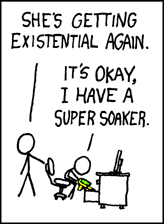
Cory Efram Doctorow is a Canadian-British blogger, journalist, and science fiction author who served as co-editor of the blog Boing Boing. He is an activist in favour of liberalising copyright laws and a proponent of the Creative Commons organization, using some of its licences for his books. Some common themes of his work include digital rights management, file sharing, and post-scarcity economics.

James Gleick is an American author and historian of science whose work has chronicled the cultural impact of modern technology. Recognized for his writing about complex subjects through the techniques of narrative nonfiction, he has been called "one of the great science writers of all time". He is part of the inspiration for Jurassic Park character Ian Malcolm.
Dinosaur Comics is a constrained webcomic by Canadian writer Ryan North. It is also known as "Qwantz", after the site's domain name, "qwantz.com". The first comic was posted on February 1, 2003, although there were earlier prototypes. Dinosaur Comics has also been printed in three collections and in a number of newspapers. The comic centers on three main characters, T-Rex, Utahraptor and Dromiceiomimus.
Ghost is a written or spoken word game in which players take turns adding letters to a growing word fragment, trying not to be the one to complete a valid word. Each fragment must be the beginning of an actual word, and usually some minimum is set on the length of a word that counts, such as three or four letters. The player who completes a word loses the round and earns a "letter", with players being eliminated when they have been given all five letters of the word "ghost".
Boing Boing is a website, first established as a zine in 1988, later becoming a group blog. Common topics and themes include technology, futurism, science fiction, gadgets, intellectual property, Disney, and left-wing politics. It twice won the Bloggies for Weblog of the Year, in 2004 and 2005. The editors are Mark Frauenfelder, David Pescovitz, Carla Sinclair, and Rob Beschizza, and the publisher is Jason Weisberger.

Yakov Isidorovich Perelman was a Russian Empire and Soviet science writer and author of many popular science books, including Physics Can Be Fun and Mathematics Can Be Fun.

Saturday Morning Breakfast Cereal (SMBC) is a webcomic by Zach Weinersmith. The gag-a-day comic features few recurring characters or storylines, and has no set format; some strips may be a single panel, while others may go on for ten panels or more. Recurring themes in SMBC include science, research, superheroes, religion, romance, dating, parenting and the meaning of life. SMBC has run since 2002 and is published daily.

Randall Patrick Munroe is an American cartoonist, author, and engineer best known as the creator of the webcomic xkcd. Munroe has worked full-time on the comic since late 2006. In addition to publishing a book of the webcomic's strips, titled xkcd: Volume 0, he has written four books: What If?, Thing Explainer, How To, and What If? 2.

xkcd, sometimes styled XKCD, is a webcomic created in 2005 by American author Randall Munroe. The comic's tagline describes it as "a webcomic of romance, sarcasm, math, and language". Munroe states on the comic's website that the name of the comic is not an initialism but "just a word with no phonetic pronunciation".

Geohashing is an outdoor recreational activity inspired by the webcomic xkcd, in which participants have to reach a random location, prove their achievement by taking a picture of a Global Positioning System (GPS) receiver or another mobile device and then tell the story of their trip online. Proof based on non-electronic navigation is also acceptable.

Borderlands Books is a San Francisco independent bookstore specializing exclusively in science fiction, fantasy and horror.

"Time" is the 1,190th strip of Randall Munroe's webcomic xkcd. Beginning with a single frame published at midnight on March 25, 2013, the image was updated every 30 minutes until March 30, 2013, and then every hour for 118 days, ending on July 26 with a total of 3,102 unique images. Each image represented a single frame in a larger story.
Darryl Cunningham is a British author and cartoonist who has written the books Science Tales, Psychiatric Tales, The Age of Selfishness and Billionaires: The Lives of the Rich and Powerful.
"The Maiden Flight of McCauley's Bellerophon" is a science fiction/magical realism novella by the American writer Elizabeth Hand. It was first published in the Neil Gaiman/Al Sarrantonio-edited anthology Stories: All-New Tales, in 2010, and subsequently republished in Hand's 2012 anthology Errantry: Strange Stories from Small Beer Press.

What If?: Serious Scientific Answers to Absurd Hypothetical Questions is a 2014 non-fiction book by Randall Munroe in which the author answers hypothetical science questions sent to him by readers of his webcomic, xkcd. The book contains a selection of questions and answers originally published on his blog What If?, along with several new ones. The book is divided into several dozen chapters, most of which are devoted to answering a unique question. What If? was released on September 2, 2014 and was received positively by critics. A sequel to the book, titled What If? 2, was released on September 13, 2022.
Notable events of 2013 in webcomics.

Maciej Cegłowski is a Polish-American web developer, entrepreneur, speaker, and social critic, based in San Francisco, California. He is the owner of the bookmarking service Pinboard, which he calls a social bookmarking site for introverts.
Crocodile in Water, Tiger on Land is an Indian webcomic series by an anonymous writer and illustrator duo. The webcomic launched in 2010 and is named after a Bengali saying similar to "being caught between the devil and the deep blue sea." It uses visual metaphors in order to communicate ideas related to the Indian social and political system, as well as the "absurdity of modern life." A book printing the webcomic was released in 2015.
Notable events of 2015 in webcomics.

How To: Absurd Scientific Advice for Common Real-World Problems is a book by Randall Munroe in which the author provides absurd suggestions based in scientific fact on ways to solve some common and some absurd problems. The book contains a range of possible real-world and absurd problems, each the focus of a single chapter. The book was released on September 3, 2019.












